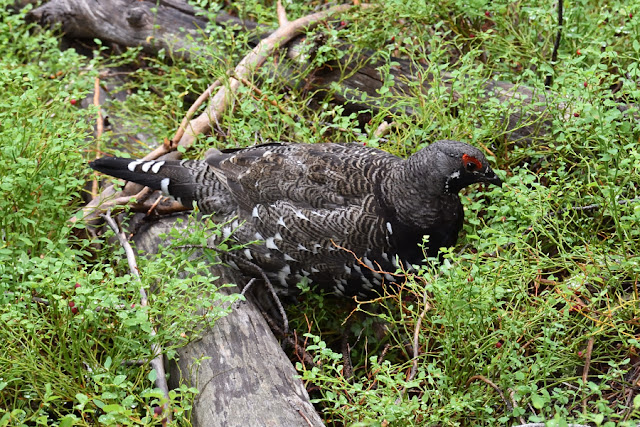The Tin Cup Hiker Trailhead at Pettit Lake provided our first try for the grouse. Soon after heading up the trail, we came upon a nice-sized group of birds comprised of Western Wood-Pewee, Willow and Dusky Flycatcher, Mountain Chickadee, Red-breasted Nuthatch, Ruby-crowned Kinglet, Western Tanager, Lazuli Bunting, White-crowned and Chipping Sparrow, Cassin's Finch, and warblers that included Nashville, Yellow, "Audubon's", Townsend's, and Wilson's. Unfortunately at the same time, rain moved in and became heavy at times. We continued up the trail for about a half-mile and then headed back to the car. A Horned Lark was seen on the way back out to Route 75.
As we continued north into the town of Stanley, the rain was reduced to light showers. Most of the clouds lifted, revealing the taller Sawtooth Mountain peaks.
All of Stanley's motels and cabins were booked for the night, but we managed to secure a cabin about 20 miles farther down the road. That problem out of the way, our next spot to try for the grouse was the Iron Creek Trailhead, southwest of the town. We hiked about a mile up the trail through prime habitat but couldn't spot any grouse. On the way back, Jason decided to go partway into the woods and walk parallel with the trail. When we were about a tenth of a mile from the parking lot, he spotted a "Franklin's" Grouse about ten feet ahead of him. I slowly walked in and we both had excellent looks at a stunning male! I retrieved my camera from the car and, as I worked my way in position for a photo, the sun came out as if on cue and helped light up the bird.
This wider view shows how well this grouse blends into its surroundings, closely matching the colors of the logs.
Other birds seen in the area included Hammond's Flycatcher, "Audubon's" Warbler, Western Tanager, Lincoln's Sparrow, Cassin's Finch, Red Crossbill, and Pine Siskin.
All the stars and planets had aligned, allowing us to see all three "usually difficult to find" target birds in the first three days of the trip, something I never expected to happen. With all the success, we now had four whole days to play with. It was getting late in the day and in the book, "A Birder's Guide to Idaho", it mentioned that some of the nearby meadows might have Great Gray Owls. A few miles farther west on Route 21, we stopped at the Park Creek Overlook. Soon after we got out of the car, Jason heard what he thought were young birds calling. We hiked the hillside along the meadow and soon found a Great Gray Owl perched atop a tree in the meadow. We got to see it make several attempts to catch prey.
In the woods far across the meadow were two young Great Grays calling to the parent that I managed to get a documentation photo of.
The area where the Great Grays were also produced Sandhill Crane, Common Nighthawk, Sage Thrasher, and Brewer's and Vesper Sparrow. The area south of the parking lot had burned in recent years and looked like a good place to try for Three-toed Woodpecker, so we figured we drive back in the morning and give it a try. We ate at a restaurant in Stanley, watched a Broad-tailed Hummingbird at a nearby feeder, and celebrated our good fortunes with ice cream.
While staying the night in a nice little cabin at Torrey's Burnt Creek Inn, we discussed what would be the best way to spend our four "free" days. Jason mentioned that Yellowstone National Park wasn't that far away and that he'd like to try and see the Gray Wolves there. I had just been there last year with my wife, but we never had the time to look for the wolves and had never seen Grizzly Bear in the park, so we agreed that we'd bird the Stanley area in the morning and head towards Yellowstone in the afternoon. Since it's practically impossible to book anything last minute in and around Yellowstone, I booked the Motel 6 in Rexburg, Idaho for the next two nights to make sure we had a place to stay.















No comments:
Post a Comment